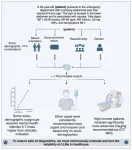(Press-News.org) Meeting the unmet need for a vaccine is the top priority for researchers studying Lyme disease, which infects about 476,000 people in the U.S. each year and can come with severe complications such as ongoing fatigue and joint issues. Vaccine developers have come close to success, but no human vaccine has yet been commercially viable.
After decades of trial and error, a promising new target is emerging—the Lyme bacterial protein CspZ, which the bacteria use to evade detection from the body’s immune system. CspZ first emerged as a candidate while scientists were looking for proteins that might be evolutionarily conserved across different Lyme bacteria strains and so generate a broad protective response.
“We've known for years that CspZ would be an ideal vaccine target because it's produced in abundance during infection, but the challenge was that in its natural form, the protein doesn't trigger a strong immune response," said Yi-Pin Lin, an associate professor of infectious disease and global health at Cummings School of Veterinary Medicine at Tufts University. "To get around this, we needed to engineer the protein's structure to reveal hidden regions that the immune system could recognize and respond to effectively."
It took several attempts, but Lin and his collaborators identified the specific tweaks to CspZ’s genetic code to create an engineered protein that produced a robust immune response in pre-clinical studies in mice. With this success and seeing that mice and human immune cells react similarly to the modified CspZ protein—giving hope that this could carry over to patients—the researchers now wanted to use three-dimensional imaging to better understand how their new vaccine target works.
Their latest study, appearing April 7 in the journal Nature Communications, shows that the modified CspZ triggers an immune response targeting the CspZ protein’s exposed “Achilles heel.” Normally, the native CspZ remains hidden from the immune system by binding to molecules responsible for detecting dangerous bacteria or parasites, making it inaccessible to immune defenses. However, the modified CspZ trains the immune system to produce antibodies that recognize CspZ’s exposed region in its altered form, making it much easier for the host’s white blood cells to find and eliminate Lyme disease-causing bacteria.
"What we also found through structure-based vaccine design is that we could further modify CspZ to make the molecule more stable at body temperature,” said Lin, who is a co-corresponding author on the study. “This allows the engineered CspZ protein to persist longer in the body to promote continuous production of protective antibodies, which significantly reduces how many vaccine booster shots are needed."
The work was led by an international team of experts, including Lin at Tufts University; Maria Elena Bottazzi and Wen-Hsiang Chen at the Texas Children’s Hospital Center for Vaccine Development, Baylor College of Medicine; Ching-Lin Hsieh, formerly at the University of Texas; and Kalvis Brangulis at the Latvian Biomedical Research and Study Centre and Riga Stradins University.
The researchers plan to explore several applications for their patented vaccine strategy against Lyme disease. This may include working with commercial partners to develop platforms for the safe testing and delivery of engineered CspZ protein-based vaccines by conducting human clinical trials or immunizing natural populations of the wild, white-footed mice that carry the bacteria that ticks transfer to infect humans.
“Vaccine development is a very long process, and when we're doing experiments, 90% of the time they don't work," said Lin. "But having a vaccine is better than having no vaccine, so having collaborators who see problems differently helped us overcome challenges at each step.”
Research reported in this article was supported by the National Institutes of Health’s National Institute of Allergy and Infectious Diseases and the U.S. Department of Defense Congressionally Directed Medical Research Programs. Complete information on authors, funders, methodology, limitations and conflicts of interest is available in the published paper.
The content is solely the responsibility of the authors and does not necessarily represent the official views of the funders.
END
Alternative approach to Lyme disease vaccine development shows promise in pre-clinical models
International research team finds genetic engineered Lyme bacterial proteins could offer long-standing protection against infection while requiring fewer vaccinations
2025-04-07
ELSE PRESS RELEASES FROM THIS DATE:
Equitable access to digital technologies may help improve cardiovascular health
2025-04-07
Statement Highlights:
Mobile health technologies, such as wearable devices, mobile health apps and telehealth or remote coaching, have shown potential to help people start and maintain heart-healthy behaviors, such as eating a healthy diet, increasing physical activity, quitting smoking, monitoring sleep and more.
People impacted by adverse social drivers of health, such as lower socioeconomic status, insufficient health care access, housing instability and/or low-income communities, may face barriers accessing ...
Is AI in medicine playing fair?
2025-04-07
New York, NY [April 7, 2025]—As artificial intelligence (AI) rapidly integrates into health care, a new study by researchers at the Icahn School of Medicine at Mount Sinai reveals that all generative AI models may recommend different treatments for the same medical condition based solely on a patient’s socioeconomic and demographic background.
Their findings, which are detailed in the April 7, 2025 online issue of Nature Medicine [DOI: 10.1038/s41591-025-03626-6], highlight the importance of early detection and intervention to ensure that AI-driven care is safe, effective, and appropriate for all.
As ...
Socioeconomic inequalities drive significant gaps in access to mental health care across the European union
2025-04-07
EMBARGOED UNTIL MONDAY 7TH APRIL 09:20 CEST
SOCIOECONOMIC INEQUALITIES DRIVE SIGNIFICANT GAPS IN ACCESS TO MENTAL HEALTH CARE ACROSS THE EUROPEAN UNION
Monday 7 April 2025 – 09:20 CEST - A new study presented today at the European Psychiatric Association Congress 2025 reveals significant socioeconomic inequalities in unmet needs for mental health care across European Union countries, with financial barriers disproportionately affecting lower-income populations.
Across Europe, millions ...
Does teamwork fulfill the goal of project-based learning?
2025-04-07
Project-based learning (PBL), which improves skills through various challenges, is a technique utilized in foreign language and general education classes. Though group work in PBL is actively carried out, the impact of the environment and team size on the motivation to learn has not been fully examined. Further, individual factors, such as language ability, can affect motivation, but it is not clear what effect group work has on these differences.
Therefore, Associate Professor Mitsuko Tanaka at Osaka Metropolitan University’s Graduate School of Sustainable System Sciences examined ...
Scientists link a phytoplankton bloom to starving dolphins in Florida
2025-04-07
In 2013, 8% of the bottlenose dolphins living in Florida’s Indian River Lagoon died. Investigations have now revealed that the dolphins may have starved because key habitats for nutritious prey were destroyed by a phytoplankton bloom. This bloom was driven by the accumulation in the lagoon of fertilizer, effluent from septic tanks, and other by-products of human activity that are rich in nutrients like nitrogen and phosphorus.
“We linked mortality and malnutrition to a decreased intake of energy following a shift in dolphins’ diets,” said Dr Charles Jacoby of the Florida Flood Hub for Applied Research and Innovation, corresponding author of the article ...
Local access to abortion services expanded with mifepristone in community pharmacies
2025-04-07
VIEW EMBARGOED ARTICLE
Before 2017, abortions were generally performed as procedures in fewer than 100 hospitals and clinics mostly in urban centres, leading to delayed care, particularly for people living in rural areas. Medication abortions, mainly via off-label use of methotrexate, were infrequent.
Researchers looked at population data from ICES to examine abortion service availability changes in Ontario from January 2017 to December 2022. Between 2017 and 2022, there were more than 226 000 abortions provided to 175 091 people. The proportion ...
KIMM lays groundwork for global expansion of “K-Machine” through strengthened international partnerships in Europe
2025-04-07
The Korea Institute of Machinery & Materials (President Seog-Hyeon Ryu, hereinafter referred to as KIMM) has signed international cooperation agreements with research institutions in Slovenia, a manufacturing technology powerhouse in Eastern Europe, and Germany, a leading country in advanced technologies in Europe. These agreements focus on virtual reliability prediction and carbon-free high-temperature heat pump technologies, while also expanding the foundation for international joint research on autonomous machining systems.
As part of KIMM’s global cooperation initiative “With KIMM, to the World,” this partnership ...
Dietary shift after migration increases cardiovascular risk by altering the composition of an individual's gut microbiome
2025-04-07
An Amsterdam UMC-led study has found that migrants, this case from West Africa to Europe, experience a ‘clear change’ in their microbiome composition as compared to their non-migrant peers in West Africa, which expose them to an increase of cardiovascular disease. These peer-reviewed findings are published today in the journal Gut Microbes demonstrating that participants who lost specific groups of microbes or acquired specific new groups of microbes had higher rates of cardiovascular ...
Viability of hospital-based emergency care in US faces peril
2025-04-07
The viability of hospital-based emergency care in the U.S. is at risk, threatened by issues such as patients with increasingly complex needs and falling payments for physicians, according to a new RAND report.
Many of the problems facing emergency medicine are expanding in scale, including long emergency department wait times, boarding patients in emergency department beds and a high amount of uncompensated care.
The issues are in focus as the use of hospital emergency departments return to levels seen before restrictions prompted by the COVID-19 pandemic limited use of emergency departments, according to researchers.
“Urgent action is needed to sustain hospital emergency ...
Exposure to air pollution may harm brain health of older adults
2025-04-07
Long-term exposure to high levels of air pollution may harm the brain health of older adults in England, finds a new study led by UCL researchers.
The research, published in The Journals of Gerontology: Series A, found that exposure to nitrogen dioxide (NO₂) and fine particulate matter (PM2.5) is linked to lower scores in key cognitive abilities, particularly language skills.
NO₂ mainly enters the atmosphere through fuel combustion, originating from emissions of vehicles like cars, trucks, and buses, as well as power plants and off-road machinery. PM2.5 pollution in outdoor air often originates from the ...
LAST 30 PRESS RELEASES:
Scientists use ultrasound to soften and treat cancer tumors without damaging healthy tissue
Community swimming program for Black youth boosts skills, sense of belonging, study finds
Specific depressive symptoms in midlife linked to increased dementia risk
An ‘illuminating’ design sheds light on cholesterol
Who is more likely to get long COVID?
Study showcases resilience and rapid growth of “living rocks”
Naval Research Lab diver earns Office of Naval Research 2025 Sailor of the Year
New Mayo-led study establishes practical definition for rapidly progressive dementia
Fossil fuel industry’s “climate false solutions” reinforce its power and aggravate environmental injustice
Researchers reveal bias in a widely used measure of algorithm performance
Alcohol causes cancer. A study from IOCB Prague confirms damage to DNA and shows how cells defend against it
Hidden viruses in wastewater treatment may shape public health risks, study finds
Unlock the power of nature: how biomass can transform climate mitigation
Biochar reshapes hidden soil microbes that capture carbon dioxide in farmland
Reducing saturated fat intake shows mortality benefit, but only in high-risk individuals
Manta rays create mobile ecosystems, study finds
Study: Mixed results in using lipoic acid to treat progressive multiple sclerosis
Norbert Holtkamp appointed director of Fermi National Accelerator Laboratory
New agentic AI platform accelerates advanced optics design
Biologists discover neurons use physical signals — not electricity — to stabilize communication
Researchers discover that a hormone can access the brain by hitchhiking
University of Oklahoma researcher awarded funding to pursue AI-powered material design
Exploring how the visual system recovers following injury
Support for parents with infants at pediatric check-ups leads to better reading and math skills in elementary school
Kids’ behavioral health is a growing share of family health costs
Day & night: Cancer disrupts the brain’s natural rhythm
COVID-19 vaccination significantly reduces risk to pregnant women and baby
The role of vaccination in maternal and perinatal outcomes associated with COVID-19 in pregnancy
Mayo Clinic smartwatch system helps parents shorten and defuse children's severe tantrums early
Behavioral health spending spikes to 40% of all children’s health expenditures, nearly doubling in a decade
[Press-News.org] Alternative approach to Lyme disease vaccine development shows promise in pre-clinical modelsInternational research team finds genetic engineered Lyme bacterial proteins could offer long-standing protection against infection while requiring fewer vaccinations



